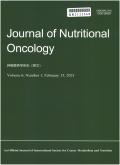Postoperative Reduction in Serum Albumin Predicts Complications after Rectal Cancer Surgery
引用次数: 1
Abstract
Abstract: Background The serum albumin (Alb) level often decreases early in the postoperative period. However, it is unclear whether a decline in the serum albumin level (ΔAlb) is a predictor of postoperative complications. We aimed to determine the relationship between the ΔAlb and complications following surgery for rectal cancer (RC). Methods We retrospectively collected the records of patients aged ≥ 18 years who underwent RC surgery between January 2015 and August 2018. We determined the cut-off value of the ΔAlb using subject working characteristic curve analysis and analyzed complications above grade II according to the Clavien-Dindo classification. Single and multifactor analyses of the risk factors for postoperative complications were performed. Results A total of 430 RC patients were included in this study. The area under the ΔAlb curve was 0.786, with a critical value of 22%. We selected 20% as the critical point for grouping patients. The total postoperative complication rate was significantly higher in patients who had a ≥ 20% serum Alb decline than those had a < 20% serum Alb decline (< 20% ΔAlb group); with rates of 51.5% and 16%, respectively (P < 0.001). A multifactorial logistic regression analysis revealed that the ΔAlb (odds ratio [OR] = 4.95, 95% CI = 3.126-7.838 P < 0.001), surgical approach (OR = 2.374, 95% CI = 1.335-4.224 P = 0.003), and blood loss (> 200 ml) (OR = 1.684, 95% CI = 1.043-2.716 P = 0.033) were independent risk factors for postoperative complications follow RC surgery. Conclusions The ΔAlb predicted the incidence of postoperative complications in patients after RC surgery. This could help identify patients at risk of complications early during the perioperative period, thereby helping to more effectively manage high-risk patients.直肠癌症术后血清白蛋白降低预测并发症
摘要:背景术后早期血清白蛋白(Alb)水平经常下降。然而,目前尚不清楚血清白蛋白水平的下降(ΔAlb)是否是术后并发症的预测因子。我们旨在确定ΔAlb与直肠癌(RC)术后并发症之间的关系。方法回顾性收集2015年1月至2018年8月期间接受RC手术的年龄≥18岁患者的记录。采用受试者工作特征曲线分析确定ΔAlb的临界值,并根据Clavien-Dindo分级对II级以上并发症进行分析。对术后并发症的危险因素进行单因素和多因素分析。结果共纳入430例RC患者。ΔAlb曲线下面积为0.786,临界值为22%。我们选择20%作为患者分组的临界点。血清Alb下降≥20%的患者术后总并发症发生率明显高于血清Alb下降< 20%的患者(< 20% ΔAlb组);分别为51.5%和16% (P < 0.001)。多因素logistic回归分析显示ΔAlb(优势比[OR] = 4.95, 95% CI = 3.126 ~ 7.838 P < 0.001)、手术入路(OR = 2.374, 95% CI = 1.335 ~ 4.224 P = 0.003)、出血量(> 200 ml) (OR = 1.684, 95% CI = 1.043 ~ 2.716 P = 0.033)是RC术后并发症的独立危险因素。结论ΔAlb可预测RC术后并发症的发生率。这有助于在围手术期早期识别有并发症风险的患者,从而有助于更有效地管理高危患者。
本文章由计算机程序翻译,如有差异,请以英文原文为准。
求助全文
约1分钟内获得全文
求助全文

 求助内容:
求助内容: 应助结果提醒方式:
应助结果提醒方式:


